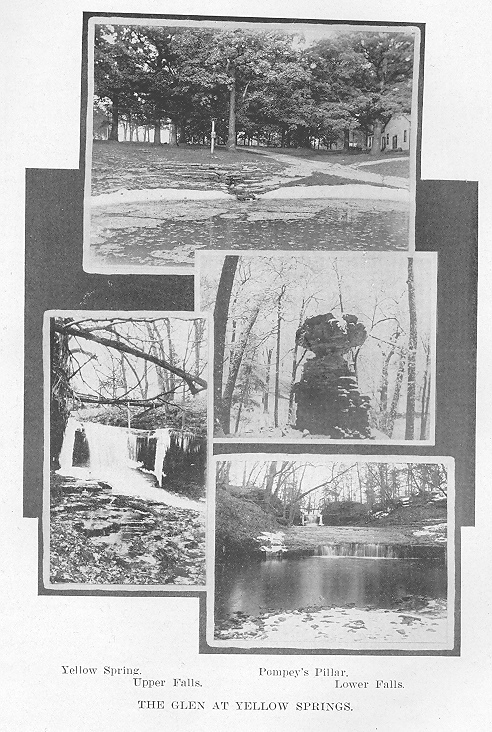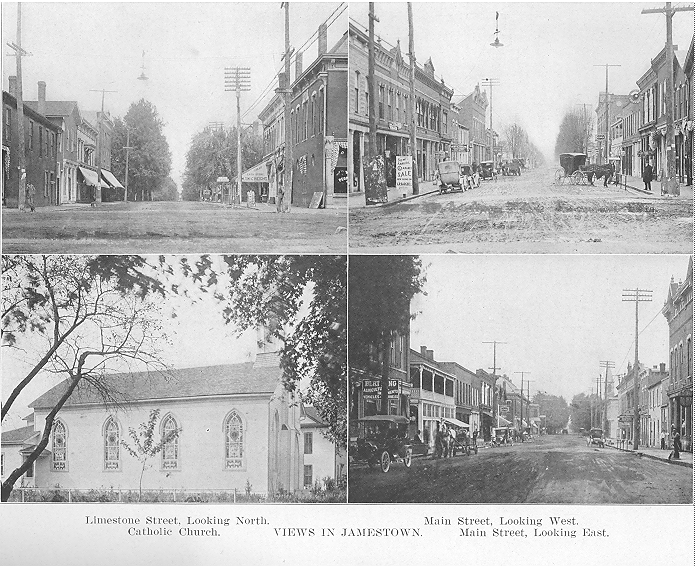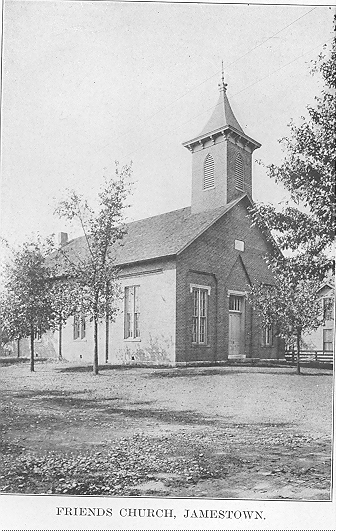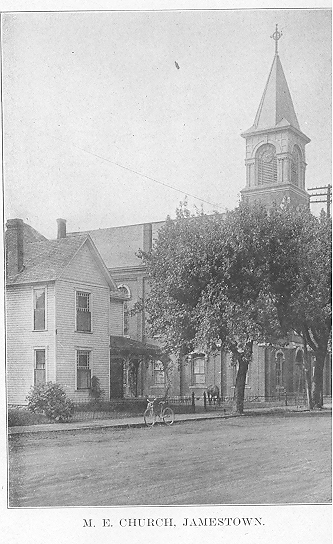GREENE COUNTY, OHIO - 375
Harvey Owens; butcher, Jacob Cultice; building and loan association, Andrew Jackson, secretary ; cement worker, Arthur Townsley, J. H. McMillan; cigars, Sherman Jones ; churches, Reformed Presbyterian, United Presbyterian, Reformed Presbyterians (Old Style), Methodist Episcopal, African Methodist Episcopal, Colored Baptist; clothing store, G. H. Hartman; coal dealers, D. S. Ervin, Andrews Brothers, Kerr & Hastings Brothers; cream stations, Houstonia Creamery Company, J. W. Long Company, West Jefferson Creamery Company; contractors, Iliff Brothers; college, Cedarville College; draymen, Harvey Myers, Fred Kennon; dry goods, J. C. Barber ; dry cleaning, J. Herndon ; drug store, A. E. Richards, C. N. Ridgeway ; electrician, E. G. Lowry, Fred Milton; elevator, Kerr & Hastings Brothers; feed and grain, Kerr & Hastings Brothers, Andrews Brothers ; furniture, J. H. McMillan, J. A. Barr; general stores, Kerr & Hastings Brothers; Robert Bird & Sons Company ; groceries, B. H. Little, J. E. Post, W. W. Trout, L. H. Sullenberger, M. C. Nagley ; hardware, R. M. McKee, G. A. Shrodes, C. N. Stuckey & Son ; harness, Kerr & Hastings Brothers; hotel, Cedar Inn, Mrs. George Smith, proprietor ; house mover, Arthur Townsley ; ice dealer, D. S. Ervin; insurance, W. L. Clemans; jewelry, J. W. Johnson; junk dealer, William Bose; livery stable, George Boyd ; lime and stone, Cedarville Lime & Stone Company ; lodges, Masons, Odd Fellows, Knights of Pythias ; mayor, D. H. McFarland; meat markets, Mrs. C. C. Weimer & Son, Hayes Bates; moving pictures, Ralph Murdock ; music teachers, George Siegler, Helen Oglesbee; newspaper, Cedarvville Herald, Karlh Bull, owner and editor ; notion store, Mrs. Anna Boyd; painters, Thomas N. Tarbox; paperhangers, Calvin Ewry, Foster Banks, Charles Spencer ; paper mill, Hagar Strawboard & Paper Company ; photographer, J. Victor Tarr ; physicians, E. C. Oglesbee, Myron I. Marsh, John O. Stewart ; pool rooms, George Boyd, Charles Spencer ; postoffice, William A. Turnbull, postmaster ; plumber, John Steele; railroad agent, Whitington ; real estate, Cedarville Realty Company, W. L. Clemans, George Smith ; restaurant, Mrs. George Smith, J. A. Hinton, Charles Spencer ; saw-mill, Tarbox Lumber Company ; schools, public, L. D. Parker, principal; seminary, theological, Reformed Presbyterian; shoe shining, Sherman Jones; shoe repairer, Edward Richards ; Standard Oil Company, George Marshall, local manager; stock buyer, Frank Townsley; stone crusher, Cedarville Lime & Stone Company ; telephone, Cedarville Telephone Company; telegraph operators, J. R. Wells, Charles Payne, Hugh Grindle; tile, Andrews Brothers, Kerr & Hastings Brothers ; undertaker, J. H. McMillan, J. A. Barr, Nagley Brothers ; veterinarian, Leo Anderson.
CHAPTER XXIV.
THE CITY OF YELLOW SPRINGS.
The city of Yellow Springs has had an interesting and eventful history. Though it was only a collection of a few houses until the establishment of Antioch College here in 1852, yet it has a history which goes back nearly a half century prior to that year. The name of the city is suggestive of the wonderful spring of water which still gushes forth on the old Neff farm. It was this spring that attracted the Indians to the site and was also responsible for the early settling of the place by white men. This spring has been the means during the past century of attracting to the place thousands of people who came to try its healing qualities. Here came the families of some of the best-known generals of the Civil War during the days when that struggle was being waged. The composition of the waters of this celebrated spring show its main constituents to be as follows : Carbonate of lime, 92.97 per cent.; carbonate of magnesia, 2.42 ; iron and alumina, 3.80; silicous matter, .80.
Lewis Davis, a son of Owen Davis, the old miller, was undoubtedly the first settler on the site of the present city, but it seems that he made only a short stay in the township. The first settler is mentioned at length in the history of Miami township. The township was not organized until June 8, 1808, but the postoffice at Yellow Springs has an unbroken record from May 10, 1805, down to the present time. This fact makes it certain that there was at least a tavern or store at the place continuously for the first half of the town's history. It is not possible to trace the growth of the place year by year prior to 1852. It is stated that when the railroad reached the place in the summer of 1846 there was only the Methodist church building and two or three small houses on the site. Therefore, the history of the town from 1803 to 1846 is practically nil. But there have been a few events chronicled during these years which are worth setting forth.
FIRST CABIN ON THE TOWNSITE.
It seems that Thomas Fream must have succeeded Lewis Davis as the second settler on the site, or at least, Fream was some place in the immediate vicinity. He was granted a license in 1805 to conduct a tavern on the site. Unfortunately, the exact location of this tavern of Fream is not known, but the official record shows that he was succeeded as postmaster by James Miller

GREENE COUNTY, OHIO - 377
on October 1, 1810. This may mean that he sold his tavern, and he probably had some sort of a store in connection, to Miller. Another authority is responsible for the statement that the first log cabin on the present site of Yellow Springs was built by Elisha Mills, also mentioned elsewhere, this cabin becoming a part of the Yellow Springs hotel in after years. Mills became postmaster of the village, if it may be so called, by an appointment dated July 15, 1823, continuing in the office for the next ten years.
The facts of the situation are that with no records other than those of the postoffice it is impossible to establish a sequence for the various business enterprises which were in the town prior to 1846. Some of these business men of this period were the following : Oliver Farnsworth, who started the first newspaper in 1830, Benjamin Deaver, who opened the first tanyard in 1834; Abner and Betsey Morton, the first colored people, located in the village in 1835; George Confer, who started the first cider mill in 1836, this same year bringing John Hammond, the first carpenter, into the village ; the Methodists built a church in 1840 on the site of the present post-office, their building being the first one west of the railroad which came in 1846; Israel Baker opened the first shoeshop in 1842; the year 1842 brought Frank Hafner, the first baker, and Andrew Modie, the first painter ; the first school house within the present limits of the corporation was erected in 1845, the same building being later used as an Episcopal church, the building being used for school purposes in 1918; the year 1846 brought the railroad to the struggling village, and here begins a new epoch in the history of the town.
NEW EPOCH IN YELLOW SPRINGS.
The year 184.6 may very properly be taken as a turning point in the history of Yellow Springs, for with the coming of the railroad the town took on new life and began to assume the airs of a place of some importance. In this same year William Mills, a son of Elisha, one of the first settlers, began his merchandising career with A. B. Johnson as partner. They erected what was known as the Union House near where the railroad crossed Dayton street. The period between 1846 and 1853 was filled with building operations and by the latter year the place had assumed such an appearance of stability that William Mills had the courage to lay out three hundred acres into lots. It is an admitted fact that it was the coming 'of Antioch College which gave the place its sudden prosperity in the '50s. The famous educational institution was the means of attracting a number of families to the place in order that their children might avail themselves of its advantages. Scores of the professors and instructors of the college have been identified with the life of the town as well as the college. The famous col-
378 - GREENE COUNTY, OHIO
lege and the celebrated spring may be cited as being two factors which have had more to do With the city's prosperity as it stands today than anything else that might be enumerated.
To revert to the period between 1846 and 1853. The large store of Mills & Johnson, the so called Union House, has already been mentioned. In the same year, 1846, Thomas Gilmore erected a frame store building east of the Mills & Johnson store, and opened a dry-goods establishment. The site of this store is now occupied by the elevator. Gilmore was succeeded in later years by his brother, William, in the same building. In 1847 James A. Brown erected a grain elevator along the tracks of the railroad and became the first grain merchant of the town. About the time the railroad was being built, Mills. & Johnson made a proposition to the Methodist church to buy their lot and not only give the church a new lot in a more favorable location, but even donate sufficient money to erect a new building. The church had erected their small frame building in 1840, six years before the railroad reached the town, and as it turned out, the right-of-way of the railroad passed close by the church. This first building was located on the northeast corner of what is now Dayton and Corry streets on the site of the present postoffice. Mills & Johnson owned the lots adjoining the church and wished to have the entire block for business purposes. The church accepted the offer of lot No. 47, corner of Dayton and Winter streets, built a new structure and turned over the old building to Mills and Johnson. The new owners converted the old church building into a dwelling house, which later burned.
In 1848 Col. Joseph E. Wilson began the burning of lime in the village, thereby establishing an industry which was for many years the most important in the place. It was not until 1852 that the first flour-mill opened for business, the owner and operator being John Lannen. In 1855 Stephen Kershner opened a tinshop and in the same year a machine shop of some description announced that it was ready for business. It can not be said that Yellow Springs has ever been a manufacturing center of much importance. Outside of the lime industry, a flour-mill and a saw-mill there have been no manufacturing enterprises of any importance in the city. Allen Jobe established a wagon shop in 1865. In 1887 C. A. Little opened a sawmill. In 1893 the lime kiln of Ervin & Company was put in operation. The following year the Little elevator was erected.
PLATTING OF THE TOWN.
It was the coming of the railroad in the '40s, followed by the coming of Antioch College a decade later, which was responsible for the sudden growth of the town in the fore part of the '50s. The big man in the town
GREENE COUNTY, OHIO - 379
in that period was. William Mills, and it was his foresight and shrewdness that led to the platting of such an extensive tract for a townsite, and the subsequent extensive additions to the original site within a short time.
Mills had the idea that the college and the springs would draw people to the town by the hundreds, even by the thousands. The springs were already well known throughout the state, and also in adjoining states; the college was advertised in such a way as to make it one of the most talked of institutions in the West at the time. Horace Mann, its first president, was then the best and most widely known educator in the United States.
Therefore, taking everything into consideration, it is not to be won dered that Mills thought his town had a great future before it. He got his plans well in hand by 1853 and on November 23 of that year appeared before Samuel T. Owens, county surveyor and also a notary public, and received the following document, which is here introduced as the first .official record pertaining to the now flourishing town of Yellow Springs :
I do hereby certify that at the request of William Mills, Esq., the owner and proprietor, I laid off and surveyed Forest Village or Yellow Springs, as shown on the annexed map or plan, whereof the sizes of the lots, width of the streets and alleys (with very few exceptions) are all accurately marked on said map in feet and tenths ; likewise, the present magnetic bearing of said lots, streets and alleys are marked on said map. There are stones set at the places so marked and I also directed stones to be set at each of the crossings of the streets. Given under my hand and seal, this 23rd day of November, in the year of our Lord 1853.
SAMUEL T. OWENS, Surveyor G. C.
The appended map to which Owens referred shows the site to be laid out with a reckless disregard to the points of the compass. But it was a part of the general plan of Mills to avoid the regularity of the average town in the method of laying out streets. Mills was an original genius and nothing shows this more plainly than the original plat of his town. There were a total of four hundred thirty-six lots in the site, and they were of every conceivable shape and size.
ADDITIONS TO ORIGINAL PLAT.
It would have seemed that four hundred thirty-six lots would have been enough to have lasted for a while, but Mills was determined to have a town of some size, and he wanted it in a hurry. He advertised his lots far and wide throughout Ohio and in the adjoining states, in the East and West, in the staid papers of Boston and New York, and in the breezy sheets of Chicago and St. Louis. As a maker of towns this man Mills was the best the county has ever produced.
Mills had hardly offered his first group of lots for sale, before he decided that he needed a few hundred more. He added one hundred twelve lots
380 - GREENE COUNTY, OHIO
in 1855 and one hundred eighty more in 1857. It seems that Mills really did have a more definite idea of what a town should be than some of his contemporaries were willing to grant him. When he had his original three hundred fifty acres surveyed into lots, he reserved a tract of twenty acres in about the center of the tract, which, it is apparent, he wanted to preserve as a park, although he does not say so in his record of the plat. He was equally liberal in setting aside lots for churches and schools.
It should be stated that six out of the thirty-seven streets provided by the original Mills plat were more than a mile in length. Considering the natural advantages of the site, it is not surprising that the proprietor found a ready sale for hundreds of his lots at prices ranging from one hundred fifty to two hundred dollars a lot ; even prices as high as five hundred dollars were received for choice locations. Mills was a philanthropic sort of a man, the kind of a man who puts his philanthropy into practice. He hoped to build a city of ten thousand, and to this end he wanted the best citizens he could induce to settle in his town. He himself paid for the grading and graveling of the streets ; he was largely responsible for the railroad going through his town instead of through Clifton ; he was certainly responsible for the location of Antioch College here.
ADDITIONS TO ORIGINAL PLAT.
But the vision of Mills was not tempered by a sufficient knowledge of municipal affairs and the factors underlying city growth. He did not seem to realize that one can not build up a city of ten thousand anywhere he chooses. Scenery is a good and valuable asset ; likewise a good college is a valuable adjunct to the growth of a small city. But the great mass of the citizens of his proposed city of ten thousand could not make a living out of the scenery, and neither could they subsist on the college. As a result his municipal dream was only about one-tenth realized, but he should nevertheless be given credit for making the town what it is today.
The additions to the original plat of 1853, with the names of the respective proprietors, number of lots and the dates of the recording of the several plats are given in the appended table :


